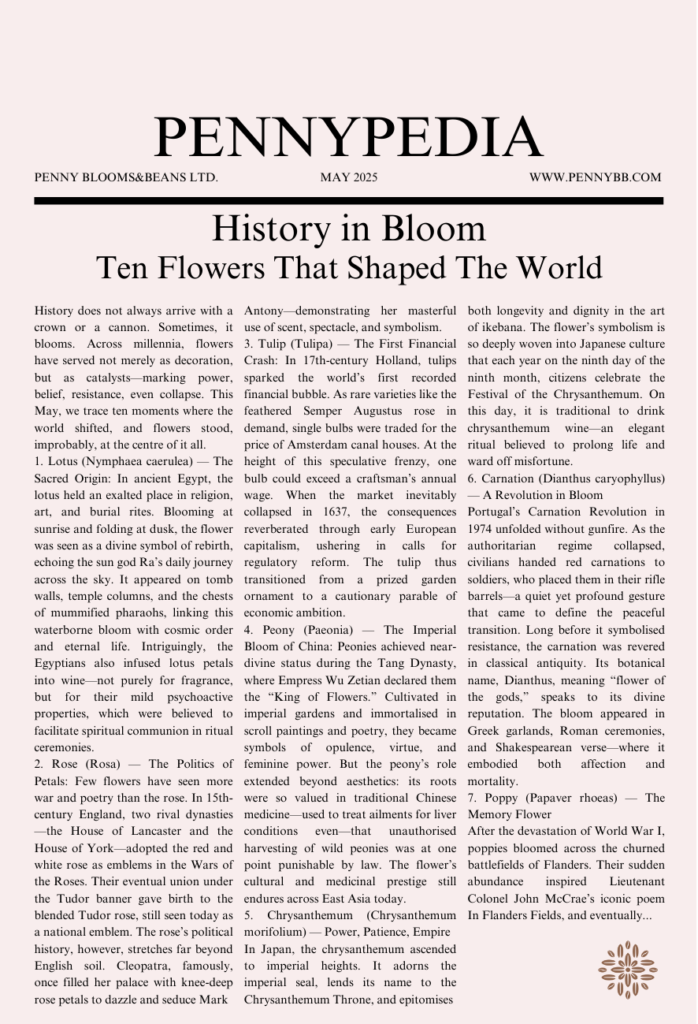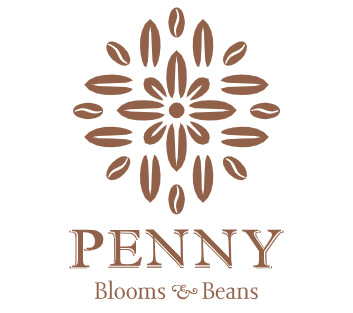
02 May History in Bloom: Ten Flowers That Shaped the World
 History does not always arrive with a crown or a cannon. Sometimes, it blooms. Across millennia, flowers have served not merely as decoration, but as catalysts—marking power, belief, resistance, even collapse. This May, we trace ten moments where the world shifted, and flowers stood, improbably, at the centre of it all.
History does not always arrive with a crown or a cannon. Sometimes, it blooms. Across millennia, flowers have served not merely as decoration, but as catalysts—marking power, belief, resistance, even collapse. This May, we trace ten moments where the world shifted, and flowers stood, improbably, at the centre of it all.
1. Lotus (Nymphaea caerulea) — The Sacred Origin
In ancient Egypt, the lotus held an exalted place in religion, art, and burial rites. Blooming at sunrise and folding at dusk, the flower was seen as a divine symbol of rebirth, echoing the sun god Ra’s daily journey across the sky. It appeared on tomb walls, temple columns, and the chests of mummified pharaohs, linking this waterborne bloom with cosmic order and eternal life. Intriguingly, the Egyptians also infused lotus petals into wine—not purely for fragrance, but for their mild psychoactive properties, which were believed to facilitate spiritual communion in ritual ceremonies.
2. Rose (Rosa) — The Politics of Petals
Few flowers have seen more war and poetry than the rose. In 15th-century England, two rival dynasties—the House of Lancaster and the House of York—adopted the red and white rose as emblems in the Wars of the Roses. Their eventual union under the Tudor banner gave birth to the blended Tudor rose, still seen today as a national emblem. The rose’s political history, however, stretches far beyond English soil. Cleopatra, famously, once filled her palace with knee-deep rose petals to dazzle and seduce Mark Antony—demonstrating her masterful use of scent, spectacle, and symbolism.
3. Tulip (Tulipa) — The First Financial Crash
In 17th-century Holland, tulips sparked the world’s first recorded financial bubble. As rare varieties like the feathered Semper Augustus rose in demand, single bulbs were traded for the price of Amsterdam canal houses. At the height of this speculative frenzy, one bulb could exceed a craftsman’s annual wage. When the market inevitably collapsed in 1637, the consequences reverberated through early European capitalism, ushering in calls for regulatory reform. The tulip thus transitioned from a prized garden ornament to a cautionary parable of economic ambition.
4. Peony (Paeonia) — The Imperial Bloom of China
Peonies achieved near-divine status during the Tang Dynasty, where Empress Wu Zetian declared them the “King of Flowers.” Cultivated in imperial gardens and immortalised in scroll paintings and poetry, they became symbols of opulence, virtue, and feminine power. But the peony’s role extended beyond aesthetics: its roots were so valued in traditional Chinese medicine—used to treat ailments for liver conditions even—that unauthorised harvesting of wild peonies was at one point punishable by law. The flower’s cultural and medicinal prestige still endures across East Asia today.
5. Chrysanthemum (Chrysanthemum morifolium) — Power, Patience, Empire
In Japan, the chrysanthemum ascended to imperial heights. It adorns the imperial seal, lends its name to the Chrysanthemum Throne, and epitomises both longevity and dignity in the art of ikebana. The flower’s symbolism is so deeply woven into Japanese culture that each year on the ninth day of the ninth month, citizens celebrate the Festival of the Chrysanthemum. On this day, it is traditional to drink chrysanthemum wine—an elegant ritual believed to prolong life and ward off misfortune.
6. Carnation (Dianthus caryophyllus) — A Revolution in Bloom
Portugal’s Carnation Revolution in 1974 unfolded without gunfire. As the authoritarian regime collapsed, civilians handed red carnations to soldiers, who placed them in their rifle barrels—a quiet yet profound gesture that came to define the peaceful transition. Long before it symbolised resistance, the carnation was revered in classical antiquity. Its botanical name, Dianthus, meaning “flower of the gods,” speaks to its divine reputation. The bloom appeared in Greek garlands, Roman ceremonies, and Shakespearean verse—where it embodied both affection and mortality.
7. Poppy (Papaver rhoeas) — The Memory Flower
After the devastation of World War I, poppies bloomed across the churned battlefields of Flanders. Their sudden abundance inspired Lieutenant Colonel John McCrae’s iconic poem In Flanders Fields, and eventually became the global symbol of war remembrance. The poppy’s resurgence was no accident of nature—it is a species whose seeds can remain dormant underground for decades. The shellfire of the Western Front disturbed the soil, reawakening seeds that had lain silent since the Napoleonic wars. In that accidental rebirth, the poppy came to stand for sacrifice, fragility, and renewal.
8. Lily (Lilium) — Monarchy and the Divine Right
The fleur-de-lis, drawn from the shape of the lily or iris, became the visual shorthand of the French monarchy. It adorned coats of arms, tapestries, manuscripts, and cathedral façades—evoking purity, kingship, and divine right. Though abolished during the French Revolution, it later returned as a nostalgic symbol in post-Napoleonic monarchist circles. Beyond France, the fleur-de-lis was adopted by military regiments, Scouts, and even civic institutions—proof of how a single flower’s silhouette could become a transnational icon of loyalty and lineage.
9. Marigold (Tagetes erecta) — The Sun’s Flower of the Dead
In Mesoamerican cultures, marigolds were used in religious ceremonies to honour the dead. This pre-Columbian tradition lives on in Día de los Muertos, where marigold petals are strewn in doorways and on altars to guide ancestral spirits back home. Known as cempasúchil, the marigold’s vibrant colour was believed to resemble the sun, acting as a spiritual beacon. Remarkably, the same flower is also revered in Hindu traditions—offered to gods, garlanded at weddings, and strung through temples—demonstrating a shared global reverence for its bold hue and sacred scent.
10. Lavender (Lavandula angustifolia) — The Fragrance of Empire
Lavender became emblematic of domestic virtue in Victorian Britain, with Queen Victoria herself favouring it in linens, soaps, and herbal teas. As British influence expanded, so too did lavender cultivation—finding its way into colonial economies from India to Australia. It was not merely aesthetic: during the Great Plague of London in 1665, people clutched nosegays of lavender to protect themselves from “bad air,” and the flower later found its way into field medicine, used as a natural antiseptic during both World Wars. From palace parlours to battlefield tents, lavender carried an enduring reputation for calm and cleanliness.
A Living Archive
At Penny Blooms & Beans, we see flowers not simply as decorative elements, but as carriers of time, memory, and transformation. In every bloom, there is a trace of empire, revolution, faith, and healing. To arrange them is to curate a quiet exhibition of human history.
Let May’s full bloom remind us: behind every petal lies a past worth knowing.
